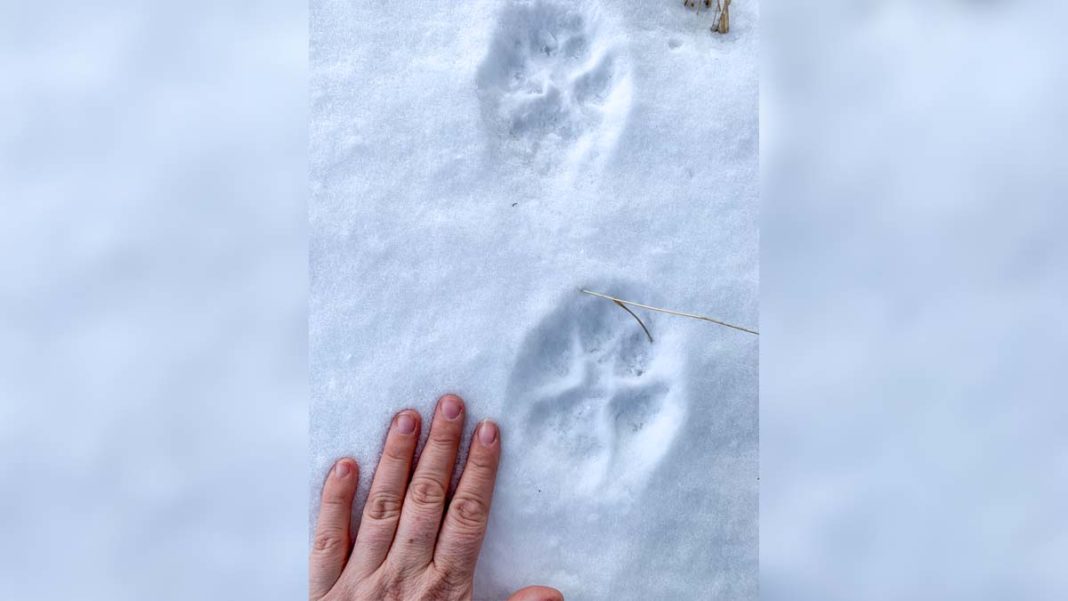POINT GRONDINE—When does a helicopter ride grow old? Well, never really if you ask Wiikwemkoong Species at Risk coordinator Theodore Flamand, who got to spend several hours recently assisting researchers from Ontario’s Ministry of Natural Resources and Forestry (MNRF) and the University of Guelph in tracking and collaring members of the eastern wolf family. “Well, seven hours at a stretch did get to be a bit much near the end,” laughed Mr. Flamand. The project, which is focussed on the eastern wolf, is particularly interesting to Mr. Flamand for a very personal reason. “I am wolf clan myself,” he shares.
The Expositor caught up with Mr. Flamand and his colleagues in the project to chat about what they were up to during those helicopter flights over Point Grondine. The project scope was limited to Point Grondine, Mill Lake, Beaverstone Bay and Ghaa Ghaa Giis Bay.
Dr. Jesse Popp, chair in Indigenous environmental science at the University of Guelph is an emerging scholar and fellow member of Wiikwemkoong Unceded Territory. Dr. Popp strives to promote inclusive science that embraces multiple ways of knowing. Dr. Popp’s research and teaching weaves Indigenous and Western ways of knowing to contribute to the advancement of environmental and ecological science.
The research team also includes: Dr. Joe Northrop who is a research scientist with the Ontario Ministry of Natural Resource and Forestry (MNRF) and an adjunct professor at Trent University. His interest lies in the factors that influence how animals move through landscapes and how those movements impact population levels; Dr. Brent Patterson, a MNRF research scientist with the ministry’s Wildlife Research and Monitoring Section in Peterborough and also an adjunct professor at Trent University. His primary research interests lie in understanding the dynamics of mammalian predator-prey systems and in determining the proximate and ultimate factors that cause changes in the distribution and abundance of animals. He has also been working on projects aimed at clarifying the taxonomy (naming and classification) and interrelations of wolves, coyotes and their associated hybrids in Ontario and beyond; and Shilah LeFeuvre a graduate student biologist with the MNRF and a member of the Chippewas of Rama First Nation. Her work on the project has been in engaging traditional knowledge to assist in interviews.
The project, one of the first of its kind in Ontario (a similar project was conducted in Quebec), seeks to combine Indigenous traditional knowledge and ways of knowing with Western science to better understand the creatures with whom we inhabit this land. Western tradition has tended to demonize wolves, the villains in countless folktales down through the ages, unlike Indigenous folklore which tends to focus more on what wolves have to teach us about living in harmony with our environment.
The wolves of particular interest in this study are the eastern wolf and the team identified the areas where wolves would be most likely to be found. A company that specializes in capturing and collaring wolves was employed for that part of the project.
“The company is very experienced,” offered Dr. Northrop, who explained that the collars are temporary, designed to fall off after a set period of time so as not to impede the natural lives of the animals. “The collars allow us to track the movements of the wolf by satellite.”
The data collected through the project will better inform the MNRF research scientists and the community about the movement and ecology of the eastern wolf as populations begin to recover.
The community outreach portion of the project is aimed at inspiring youth, particularly Indigenous youth, to learn and know more about the land and its creatures. The project also helps to inform other researchers about ethical and culturally appropriate approaches to projects.
The excitement generated by the project extends well beyond the boundaries of First Nations, however. Mr. Flamand noted how excited residents of Killarney are to learn more about the project and its findings. “The excitement is there,” he said, noting that indicates “we are going down the right path.”





